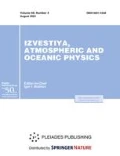Abstract
The influence of solar activity on the Earth’s global surface temperature (GST) was quantified. The method for estimation of the Granger causality was used, with analysis of the improvement of the prediction of one process by using data from another process as compared to autoprediction. Two versions of reconstructions of the solar flux variations associated with solar activity were used, according to Hoyt et al. [1997] for 1680–1992 (data H) and according to Lean et al. [2005] for 1610–2005 (data L). In general, the estimation results for the two reconstructions are reasonably well consistent. A significant influence of solar activity on GST with a positive sign was found for two periods, from the late 19th century to the late 1930s and from the latter half of the 1940s to the early 1990s, with no inertia or time delay. In these periods, up to 8 and 25% of the variance of the GST change, respectively, can be attributed to solar activity variations. The solar influence increased in the 1980s to the early 1990s according to data H and began to decrease in the latter half of the 1980s according to data L.
Similar content being viewed by others
References
Anthropogenic Climate Changes, Ed. by M. I. Budyko and Ya. A. Izrael’ (Gidrometeoizdat, Leningrad, 1987) [in Russian].
Climate Change 2007: The Physical Science Basis. Contribution of Working Group I to the Fourth Assessment Report of the Intergovernmental Panel on Climate Change, Ed. by S. Solomon et al. (Cambridge Univ. Press, Cambridge, 2007).
L. J. Gray, J. D. Haigh, and R. G. Harrison, Review of the Influences of Solar Changes on the Earth’s Climate (Hadley Centre Technical Note, Met Office, Exeter, 2005) No. 62.
I. I. Mokhov, V. A. Bezverkhnii, A. V. Eliseev, and A. A. Karpenko, “Relationship between Variations in Global Surface Temperature and Solar Activity from the Data of Observations and Reconstructions for the 17th–20th Centuries and from Model Calculations,” Dokl. Akad. Nauk 409, 1–5 (2006).
J. Moore, A. Grinsted, and S. Jevrejeva, “Is There Evidence for Sunspot Forcing of Climate at Multi-Year and Decadal Periods?,” Geophys. Rev. Lett. 33, L17705, doi:10.1029/2006GL026501 (2006).
C. W. J. Granger, “Investigating Causal Relations by Econometric Models and Cross-Spectral Methods,” Econometrica 37, 424–438 (1969).
M. Ding, Y. Chen, and S. L. Bressler, “Grange Causality: Basic Theory and Application to Neuroscience,” in Handbook of Time Series Analysis (Wiley-VCH, Weinheim, 2006), pp. 437–460.
B. Schelter, M. Winterhalder, M. Eichler, et al., “Testing for Directed Influences among Neural Signals Using Partial Directed Coherence,” J. Neurosci. Methods 152, 210 (2006).
J. Geweke, “Inference and causality in econometric time series models,” in Handbook of Econometrics, Ed. by Z. Griliches and M. D. Intrigillator (North Holland, 1984), vol. 2, pp. 1101–1144.
C. W. J. Granger, “Testing for Causality: A Personal Viewpoint,” J. Econ. Dyn. Control 2, 329–352 (1980).
W. Wang, B. T. Anderson, R. K. Kaufmann, and R. B. Myneni, “The Relation between the North Atlantic Oscillation and SSTs in the North Atlantic Basin,” J. Clim. 17, 4752–4759 (2004).
I. I. Mokhov and D. A. Smirnov, “Study of the Mutual Influence of the El Niño-Southern Oscillation Processes and the North Atlantic and Arctic Oscillations,” Izv. Akad. Nauk, Fiz. Atmos. Okeana 42, 650–667 (2006) [Izv., Atmos. Ocean. Phys. 42, 598–614 (2006)]
I. I. Mokhov and D. A. Smirnov, “El-Niño/Southern Oscillation Drives North Atlantic Oscillation As Revealed with Nonlinear Techniques from Climatic Indices,” Geophys. Rev. Lett. 33, L03708, doi:10.1029/2005GL024557 (2006).
D. V. Hoyt and K. H. Schatten, The Role of the Sun in Climate Change (Oxford Univ. Press, Oxford, 1997).
J. Lean, G. Rottman, J. Harder, and G. Kopp, “Source Contributions to New Understanding of Global Change and Solar Variability,” Solar Phys. 230, 27–53 (2005).
Y. M. Wang, J. L. Lean, and N. R. Sheeley, “Modeling the Sun’s Magnetic Field and Irradiance since 1713,” Astrophys. J. 625, 522–538 (2005).
Climate Research Unit (University of East Anglia): http://www.cru.uea.ac.uk
J. Lean, “Evolution of the Sun’s Spectral Irradiance since the Maunder Minimum,” Geophys. Rev. Lett. 27, 2425–2428 (2000).
M. S. Bartlett, Stochastic Processes (Cambridge Univ. Press, Cambridge, 1978).
K. Hlavackova-Schindler, M. Palus, M. Vejmelka, and J. Bhattacharya, “Causality Detection Based on Information-Theoretic Approaches in Time Series Analysis,” Phys. Rep. 441, 1–46 (2007).
Author information
Authors and Affiliations
Corresponding author
Additional information
Original Russian Text © I. Mokhov, D.A. Smirnov, 2008, published in Izvestiya AN. Fizika Atmosfery i Okeana, 2008, Vol. 44, No. 3, pp. 283–293.
Rights and permissions
About this article
Cite this article
Mokhov, I.I., Smirnov, D.A. Diagnostics of a cause-effect relation between solar activity and the Earth’s global surface temperature. Izv. Atmos. Ocean. Phys. 44, 263–272 (2008). https://doi.org/10.1134/S0001433808030018
Received:
Accepted:
Published:
Issue Date:
DOI: https://doi.org/10.1134/S0001433808030018




